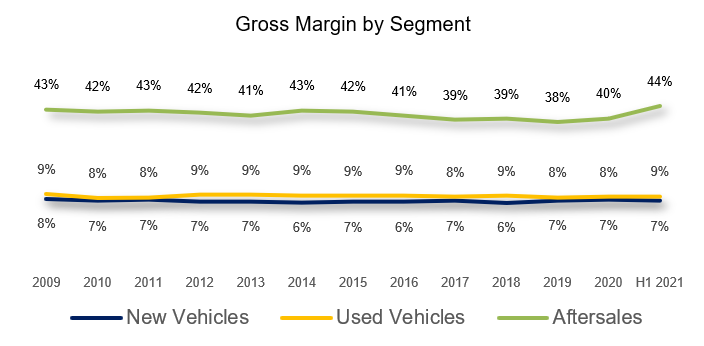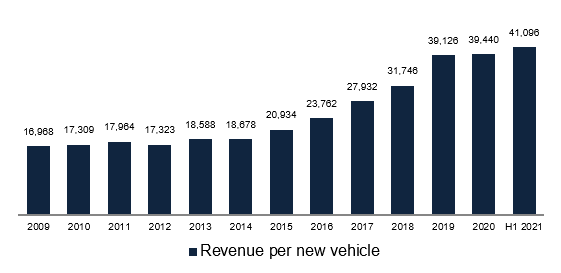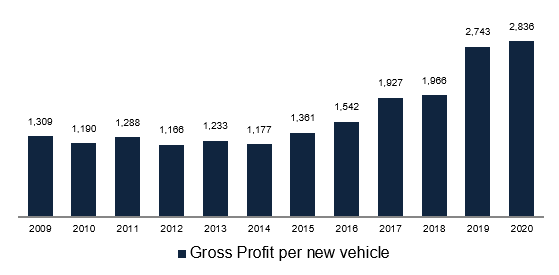
manuelbean
Member-
Posts
124 -
Joined
-
Last visited
manuelbean's Achievements
Newbie (1/14)
0
Reputation
-
Thanks Anglo. Lots of food for thought. I'm currently comparing Cambria, Vertu, Pendragon, and Lookers and I'll get to Motorpoint afterwards. Some questions on ROE: Why is Cambria different from the others? Is it because it went after the luxury segment so they'll earn more bang (pounds) for their buck (Capex, SG&A, etc)? On the SG&A and financing arrangements (not the Capex, that one I understand), how exactly do the OEM's interfere? And what is your view on the agency model? How can it hinder/benefit the dealerships? Cheers
-
Hi guys, I know that this is Vertu's thread, but I believe this data (of Cambria) to be of interest to shareholders in both. I'm planning on getting the same data for Vertu and I'll post it here when I do. The thing is, I hear people talk about how the Premium/Luxury segment supports higher margins, but I don't see that happening. The gross margin for new cars for Cambria has been steady since the IPO at around 7%. Yes, the revenue per new vehicle has been going up (these cars sure seem cheap) ... ...as has the profit per new vehicle... ...and by the way, this has happened with the "used vehicles" too. But the margin has remained flat! My best guess as to why this is happening is that, although Mclarens and Lambos and whatnot are higher ticket items, the OEM's make it so that the dealers always get the same margins (although these margins represent higher amount of £ for the dealer). This theory works well for new cars, but I haven't yet figured out why the same is happening with used cars. Thoughts?
-
Seanzy started following manuelbean
-
Wow, the things you discover... on a Poker thread. Thanks for the share.
-
Is anyone still following this one? I was wondering if someone had any insights regarding the company's growth prospects. The management talks about India and China, those sound pretty big, but how easy is it to enter those markets? Gross margin guidance is coming down to 34%, there's not much info on Wholesome, and debt is going up... they say they want to deleverage going forward, so.... Matt from Laughing Water mentions FREE entering the indexes in a few months, does anyone know how this works? How can we know which stocks will enter the indexes? Cheers
-
By the way, GE said that it will shed $30B in debt with this sale. Does that mean that $6B will go to the new entity? If GE gets $24B in cash, where do the other $6B come from? They may have the cash...
-
That is not what matters. AER is issuing $25 bn in debt and 111.5 mm shares for this deal. At current AER stock price - that equates to ~80% debt/20% equity financed transaction. Looks like AER values the GECAS assets at $34 bn (down from $36 bn at the end of 2020), so they're buying at a P/BV of 2/3 using AER stock at ~75% of BV. Accretive assuming the ROE profiles are similar but not like the ILFC deal. I may be a little bit tipsy, but $24B plus 111,5 shares at $53 ($6B) plus $1B in cash/notes is $31B, right? How do you get to the P/B of 2/3?
-
Yeah, but without knowing the amount of debt that was inside GECAS, even if we knew that the spreads were the same, we can't know for sure what the interest was, and that would be important to gauge its profitability. I understand your point, I'm just not sure if Book Value is the best metric. Yes, 2019 profit is also probably not the best metric, I know, but...
-
That is not what matters. AER is issuing $25 bn in debt and 111.5 mm shares for this deal. At current AER stock price - that equates to ~80% debt/20% equity financed transaction. Looks like AER values the GECAS assets at $34 bn (down from $36 bn at the end of 2020), so they're buying at a P/BV of 2/3 using AER stock at ~75% of BV. Accretive assuming the ROE profiles are similar but not like the ILFC deal. It matters just because I wanted to look at it from another point of view. I'm not sure my math is correct so I welcome the push-back: GECAS had $1B in profit in 2019. If Aercap is buying that for $7B, that's a 7x multiple, but there's interest costs in the mix. Let's say Aercap gets a 2% interest rate on the $24B. That's $480M that you need to take from the $1B in profits, leading to $520M of profits per year, leading to a multiple of 13.4x. The issue is, what were the interest costs before the acquisition that led to the $1B dollars in net income for GECAS that will be now replaced by the $480M?
-
Here it is. https://www.aercap.com/media/news/aercap-to-acquire-ge-capital-aviation-services/ Still no mention of how much debt GECAS has.
-
Does anyone know the amount of debt in GECAS? I've seen a fellow investor on twitter mention that the debt is around $26B, so the equity portion for a $30B deal would be $4B. The profits in 2019 were around $1B so, 4x 2019 earnings?
-
The chart and the heading don't really match, do they? I found this to be interesting https://behavioralvalueinvestor.com/blog/warren-buffett-pcc Gary makes an attempt at uncovering the profits after the acquisition (I don't know if they're disclosed on the AR, but from the article it doesn't seem so).
-
Any ideas on what Warren meant when he said that he was right on his opinion that Precision Cast Parts would "earn good returns on net tangible assets" but that he had made a mistake "in judging the average amount of future earnings"? If the earnings are lower than expected, shouldn't the return on assets be lower as well?
-
Hi guys, can anyone point me to resources on the other side of this equation (the debt markets)? I feel that the biggest risk that Aercap faces is a possible refinancing risk, and I feel that I know very little about the current debt markets. I've heard a few investors who I respect talking about the debt markets being a bit lofty these days so I want to learn more about it. Thanks
-
Annual Report and 13F differ on number of Apple shares?
manuelbean replied to manuelbean's topic in Berkshire Hathaway
Thanks for your answers. Could you please explain it as if I were 3? thanks



